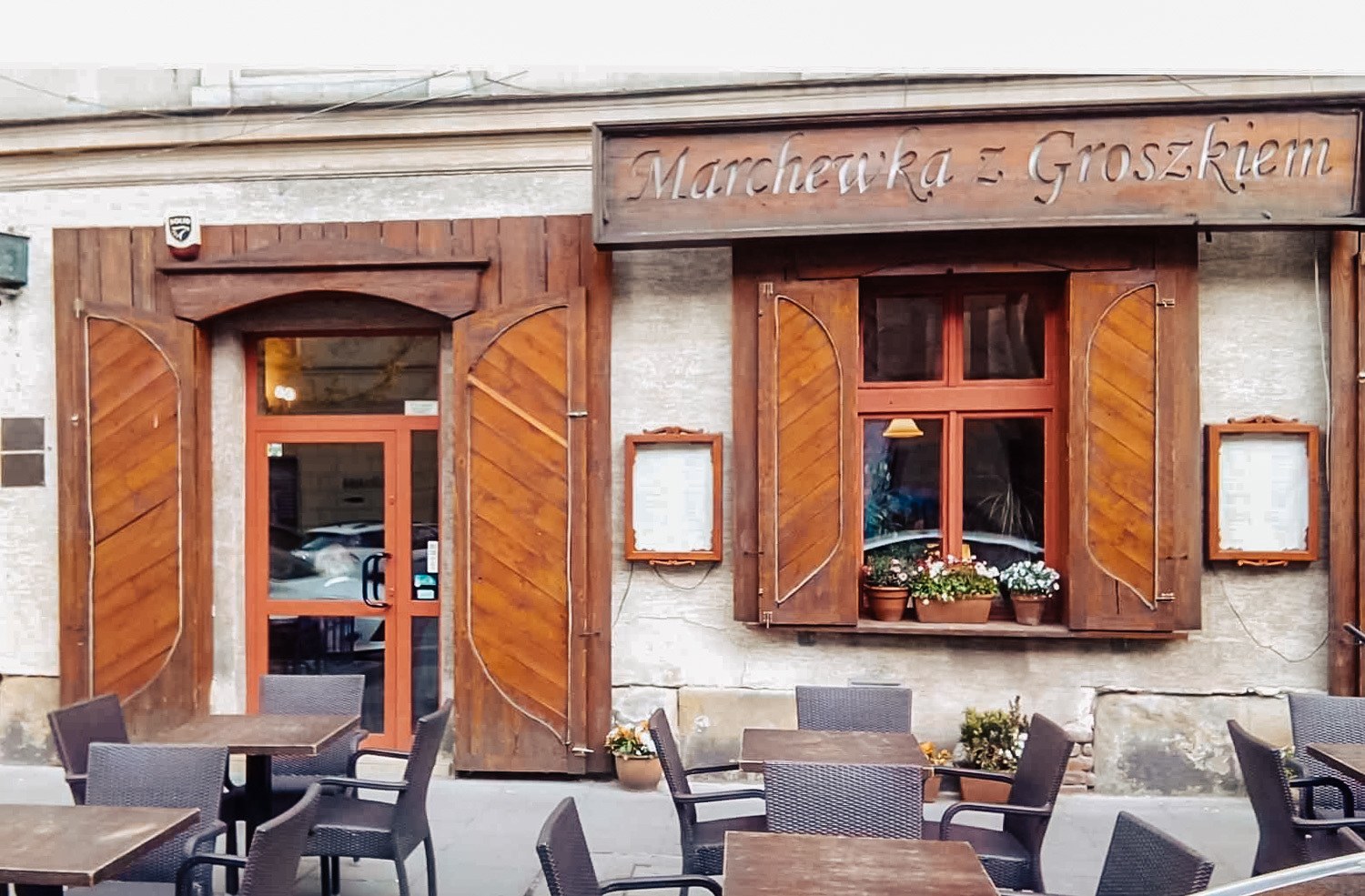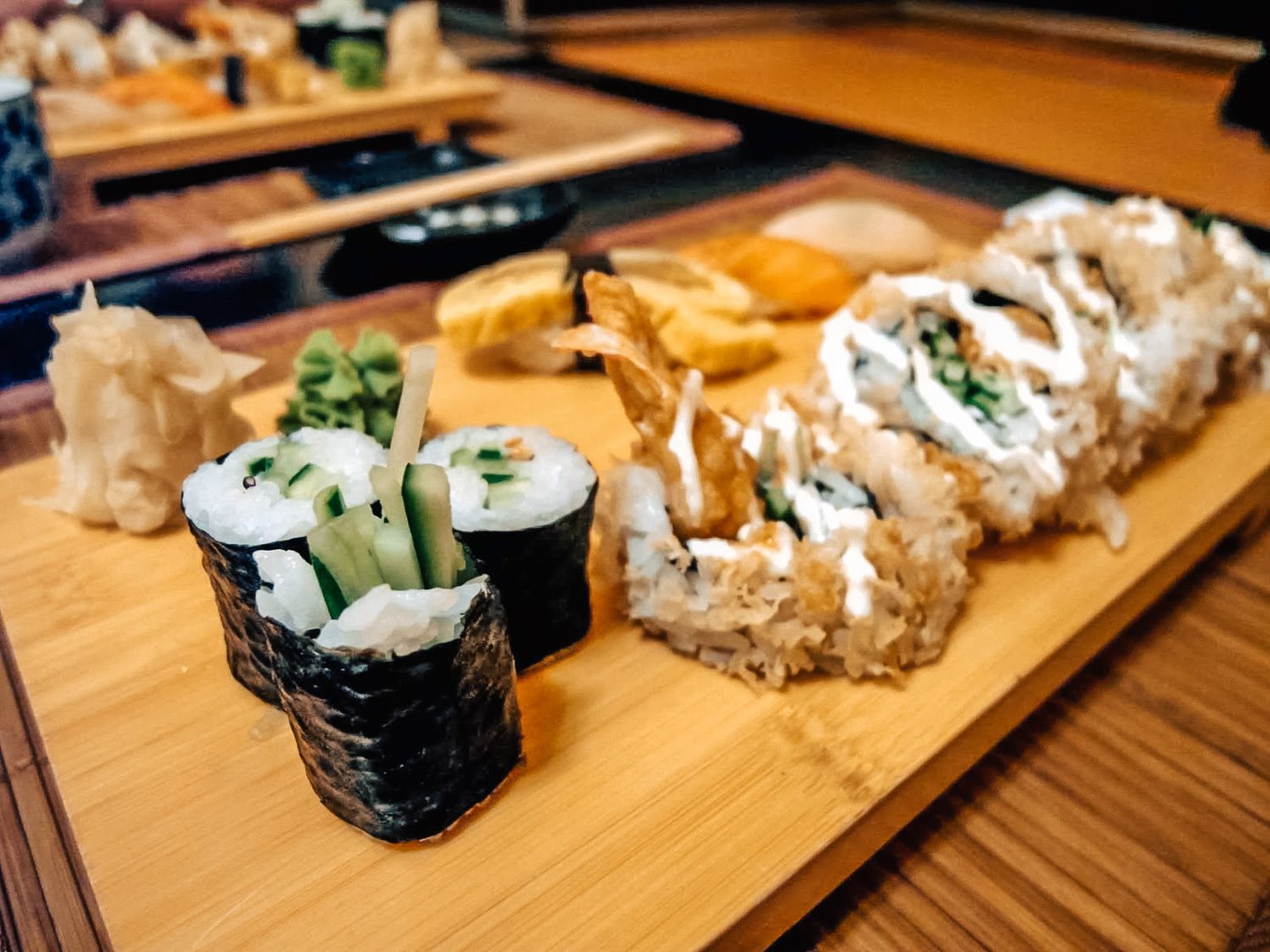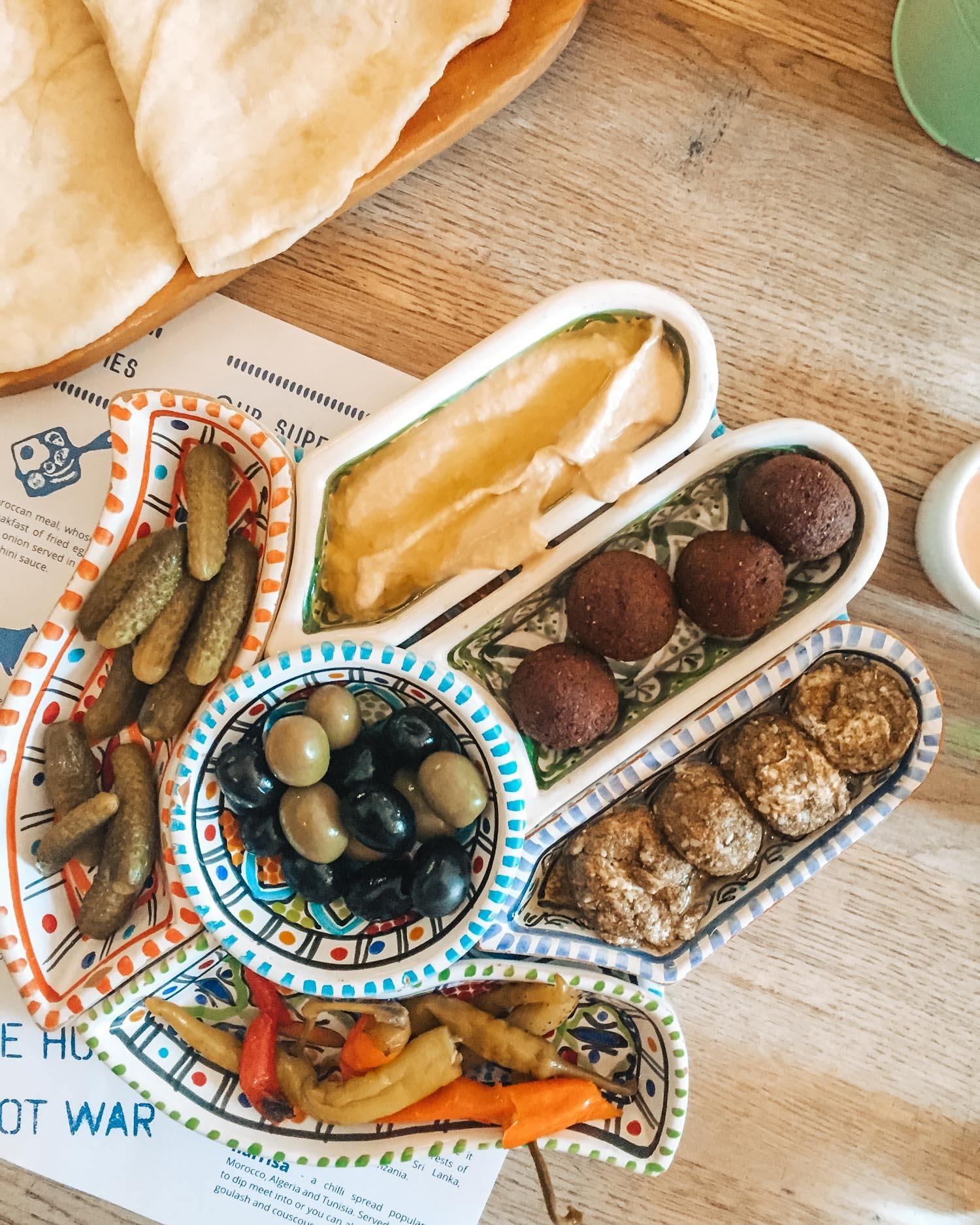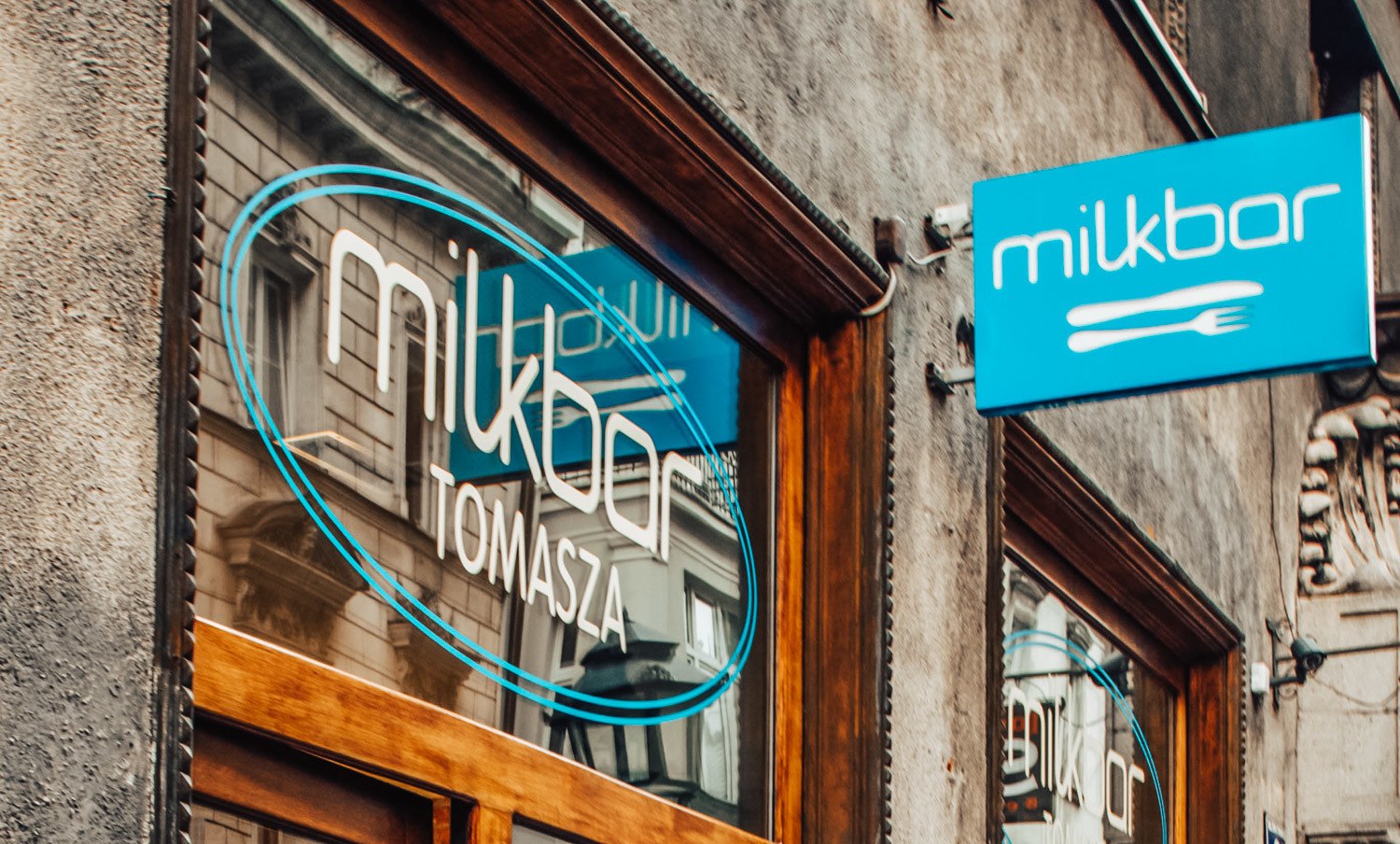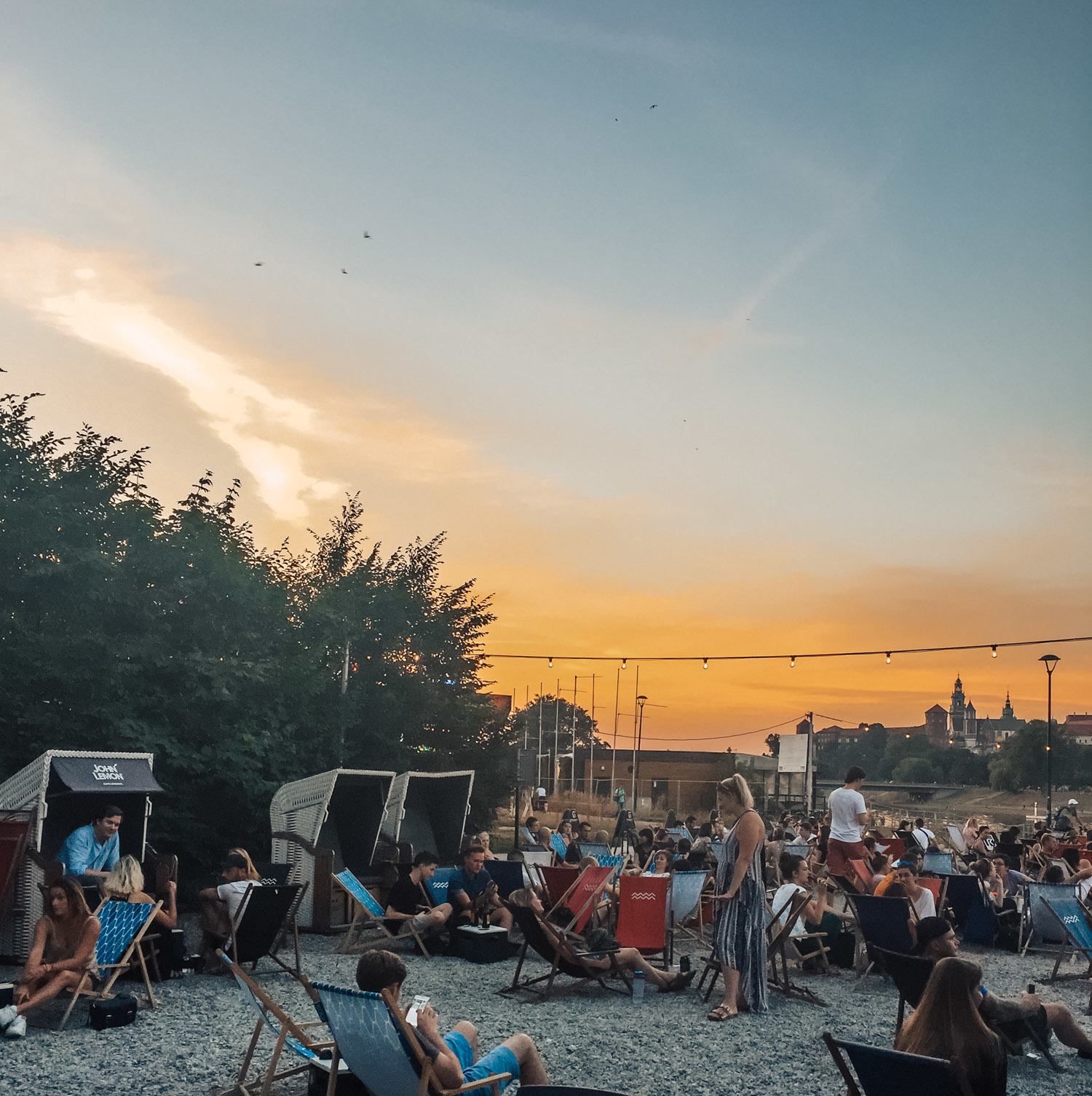Tag Archives: cab
Where to Find the Best Food in Krakow, Poland
Krakow is understated, charming and has an air of melancholy about it. You can feel the history pulsing through the small streets, decades after they were home to some of history’s most extraordinary events.
Though I was only here for two days, Krakow left an impression on me. The main areas to explore are Stare Miasto, which translates to the Old Town, and Kazimierz, the Jewish Quarter.
To go even further into the city’s emotional past, cross the Vistula River and find Schindler’s Factory. Here you’ll get a feel for a less gentrified area. While history is very evident in this small city, you can tell that residents have gone through great lengths to rebuild its bones and core.
As I explored this fascinating place, I of course ate my way through the city and below is where to find the best food in Krakow, Poland.
Marchewka z Groszkiem
Marchewka z Groszkiem serves as the perfect entry to a couple of days in Krakow. Night number one brought me to this dark, candlelit, traditional restaurant. I chose to try the dumplings stuffed with spinach and cheese.
The menu is full of country staples like Polish soups and meat and trout variations, all worth trying at some point while visiting this country.
Youmiko Sushi
Vegan sushi is a pure contradiction, but it absolutely worked here. Right in the heart of the Jewish Quarter is the small but funky Youmiko Sushi, churning out some of the most excellent tasting sushi creations I’ve come across.
The fact that all of this is done sans fish makes it all the more impressive and unique. A must try.
Hamsa
As would be expected, there are several Israeli restaurants to be found in Krakow. The one I went to was Hamsa, found behind the brick walls right in the center of Kazimierz.
The dedication to hummus is overly apparent, but the food is solid enough to push that aside. The great atmosphere makes for a very enjoyable lunch backdrop.
Milkbar Tomasza
The Polish milk bars are ex-Socialist era workers’ canteens. In their previous incarnations they were run as government subsidized cafes where workers could get a good, nutritious and affordable meal.
The first milk bar was set up in 1896, and the trend has continued into present day Krakow. Milkbar Tomasza gives you a fun and interesting back in the day feel worth experiencing.
Alchemia and Forum Przestrzenie
These are two bars you should make a stop at. Alchemia is a cocktail bar reminiscent of decades past.
Forum Przestrazenie gives a look into a modern and changing Krakow, set up for those looking to have some drinks in lounge chairs as the sun sets on the water’s edge.
The post Where to Find the Best Food in Krakow, Poland appeared first on The Blonde Abroad.
Antigua GIRLS ROAD-TRIP | Snorkeling in the Caribbean

Come explore the island of Antigua! Snorkeling in the Caribbean on Reef Riders, Shirly Heights view point , St. Johns and more!
Antigua GIRLS ROAD-TRIP | Snorkeling in the Caribbean |Hey Nadine
EPIC Sailing Race!! | Sailing Week Antigua: Chase the Race!

Chase the Race sailing race in Antigua! It’s Sailing Week and we are in for some epic boat rides! Come dance to Reggie in the Park and explore Antigua & Barbuda!
EPIC Sailing Race!! | Sailing Week Antigua: Chase the Race! |Hey Nadine
I’ve never done this before!! || Vegas

I’ve been to Vegas before, but never done this! Come Sunbuggies Dune Buggying, Top Golf, Speed Vegas, Le Reve, Giada’s and more in Vegas!
Made in Collaboration with WestJet 
I’ve never done this before!! || Vegas |Hey Nadine
the BEST MUSIC for YOUTUBE videos!

What is the BEST music for YouTube? Where do I get my Travel video music?
♬ Where I get my MUSIC : https://goo.gl/81fEcM
the BEST MUSIC for YOUTUBE videos! |Hey Nadine
A Quick Travel Guide to Dakhla, Western Sahara
Guide to Dakhla – Part 1
Brief History
Western Sahara is a disputed region in North Africa and is not a recognized country. About 80% of the territory is controlled by Morocco and 20% makes up the Sahrawi Arab Democratic Republic. There is a sand wall that separates the two regions.
From what I’ve gathered, after the Spanish gave up control of this entire territory in 1975, Morocco and Mauritania shared control, with the native Sahrawi people lacking the power needed to take over their claimed homeland. Eventually, amidst fighting, Mauritania moved out of the region and Morocco reinforced its presence. Western Sahara has been a disputed territory ever since, with most of the Sahrawi people living in and operating from refugee camps in Western Algeria.
Dakhla is under Moroccan control, with Moroccan military checkpoints throughout the area and Moroccan government buildings and flags clearly displaying their presence. However, Morocco’s sovereignty over the territory has yet to be recognized by the international community.
Some people consider the entire region to be Western Sahara, while others (such as the Moroccan government) consider the Moroccan controlled portion to be Morocco or Moroccan Sahara and only the area under the control of the Sahrawi Republic to be Western Sahara.
Like many places, the history and current situation is complicated.
Guide to Dakhla – Part 2
Entry/Visas
Most people arrive via flight from either Casablanca or Agadir or overland from Morocco or Mauritania. Entry requirements are the same as Morocco given its control over Dakhla and 80% of Western Sahara. As a result, you do not need a visa if you have a passport from the UK, EU, USA, Canada, Australia or New Zealand and you can stay in the region for 90 days. Other nationalities should check for the latest information as you might need to apply in advance for a visa.
Arrival and Departure
The very small airport is actually in the center of town. It’s about a 3 minute drive to any hotel. When you arrive you will go through a quick immigration check and then be on your way. Taxis and drivers are waiting outside the one exit and are easy to find. Overall, arriving and departing at the airport is very simple as there are only a couple of flights per day, either to Casablanca, Agadir or Las Palmas, Gran Canaria.
You can also arrive via land from the north (Morocco) or the south (Mauritania). I did not cross the land borders but from what I’ve heard, it’s a standard immigration check to enter the region.
Money
In Dakhla, the currency used is Moroccan dirhams. There are several ATMs in town and a few money exchange offices as well. There are also two ATMs at the airport in the arrivals hall. Most restaurants and smaller businesses will not accept credit cards so cash is important to have.
Language
Languages spoken in Western Sahara include Hassaniya Arabic, Moroccan Arabic, Spanish and French. In Dakhla itself, there wasn’t much Spanish spoken, mostly Arabic and French. Very little English is spoken but people are friendly and will certainly do their best to communicate.
Safety
Western Sahara is a disputed territory and as a result, there is always the possibility of conflict and political demonstrations. You should check for the latest information on safety, via local and government websites, to assess any potential danger. With that said, Morocco’s heavy military presence in Dakhla itself does keep things relatively quiet. From what I was told by those I met in the region, Dakhla is quite safe in terms of regular crime.
The main thing to watch out for is dehydration and a constant dry and dusty wind during the spring and winter that can really take its toll on you.
Guide to Dakhla – Part 3
Accommodation
Guesthouse Dar Rio Oro – There aren’t many decent sleeping options in Dakhla but this one was as solid as the reviews stated. Good sized rooms in a cozy building across the street from the water, centrally located and with a friendly Arabic, French and Spanish-speaking owner who can assist with organizing a day trip into the desert. Rooms are approximately $40 USD per night, breakfast included. (Request a room with a private bathroom and this view!)
After walking around for 1 week, the only other accommodation that looked decent were the Hotel Albaraka ($100 USD per night) and Hotel Mansour ($80 USD per night), both in the center of town. However, I don’t see any reason to pay those prices when you can get the Dar Rio Oro for less than half.
*If you use this link to book accommodation, you’ll save up to $30 on your booking (and I’ll receive $20 as well): Booking.com discount
Where to Eat
There’s a handful of restaurants in town and you can always head into one of the bakeries for a sandwich, pastry or quiche as well. The main market, while quiet, does have some stalls serving prepared food.
I ate most of my meals at the friendly Ikram’s. This small restaurant is in the exact center of town at the main traffic light and offers simple, inexpensive and tasty soups, wraps, grilled meats and fish and salads. A hearty meal costs about 50 dirhams ($5 USD). The place only has about 6 tables but seemed to be popular compared to other restaurants. Across the street is the decent Restaurant Bahia, again, with simple offerings that were, in my opinion, not as good as Ikram’s.
For proper restaurants, there is the Villa Dakhla, offering typical Moroccan dishes as well as international food at a premium price. The setting is great, right on the water and they do serve alcohol. Casa Luis serves up good Spanish-Moroccan cuisine and Chez N’Tifi, on the edge of the town center, is an excellent option for cheap, local fare. Casa Lola and Samarkand were also both recommended but I never tried them.
In the evenings, many tea shops open up in town, although most remain pretty empty. If you find one with patrons, it’s a good chance to enjoy some Moroccan tea while trying to interact with locals who will certainly be curious about you.
Getting Around
Dakhla is small! You can walk everywhere and anywhere in this town. You can even walk from the airport to the town center in about 18 minutes. If you want to visit the outskirts, which include the opposite coast, the lighthouse or the nearest beach, you might want to take a taxi.
Taxis are shared and you simply wave one down, although you might have to wait a while for one to actually pass. Then, just tell the driver your destination and get in. They’ll get you there eventually, probably picking up and dropping off another person or two along the way. At the end, you hand over 15 dirhams ($1.58 USD) and you’re good. If you’re taking a taxi to the Beach KM 25 or the popular windsurfing area, located about 20-25 minutes north of town, you’ll have to negotiate a price ahead of time.
Guide to Dakhla – Part 4
Things to Do
In Dakhla itself, there isn’t much. Lighthouse, market and Oum Lbouer, the closest beach which is about 10 minutes drive out of town.
North of Dakhla, about 20 minutes, is Beach 25 (at KM 25 on the main road) on the edge of the Dakhla Lagoon. This spot marks the start of an area that is popular with those interested in windsurfing or kitesurfing. You can actually stay out here at one of the windsurfing camps, such as Ocean Vagabond, which offer bungalows and a restaurant/bar near the water (they range from budget to quite upscale). The main downside is that apart from the beach and windsurfing camps, there is nothing else around. If you’re really into windsurfing or kitesurfing, it’s perfect. If you’re just curious, it’s best to stay in Dakhla and spend an afternoon out here.
The desert and mainland coast! If you gain anything from this guide to Dakhla, it should be the need to hire a driver with a 4×4 vehicle and let them take you off the peninsula and show you the surrounding desert and the untouched coast. It’s some of the most inhospitable land on the planet but with that comes some of the most stunning and surreal landscapes I’ve ever seen in my 19 years of travel (it even rivals the unbelievable Socotra Island). We’re talking off-roading in the rough, barren Sahara, gorgeous white sand beaches without a soul around, 100 meter tall sand dunes rising out of the water, massive sweeping plains of soft pink sand and so much more.
I’ll be posting more about this in my next post, complete with videos and photos such as this one…
(The owner of Guesthouse Dar Rio Oro organized my driver. It was actually her neighbor, Sidi, a really kind guy that charged a reasonable $80 USD for a 10 hour adventure all over the mainland.)
Want to Know More About My Trip to Dakhla?
Check out my post Travel to Dakhla: Straight Into the Unknown for the complete story.
If you have any questions after reading this guide to Dakhla, just let me know!
The post A Quick Travel Guide to Dakhla, Western Sahara appeared first on Wandering Earl.
My Travels to Dakhla, Western Sahara: Straight Into the Unknown
Imagine an eerily quiet town in North Africa, set at the edge of the Sahara Desert, right in the middle of an impossibly narrow peninsula that juts out into the Atlantic Ocean. Imagine a harsh and constant 40 kmh wind blowing into your face, with sand flying around, caught up in the gusts, and going straight into your eyes and mouth.
Looking around, you find empty intersections and very few vehicles on the streets, and you quickly notice that there’s barely any people walking around either. When someone does glide by in the distance, in their traditional hooded robe or cloth covered face to protect themselves from the elements, you wonder where the other people could possibly be.
Imagine a town with seemingly little connection to the outside world, as if it were located on an entirely different planet altogether.
Welcome to Dakhla, Western Sahara.
Why Would I Travel to Dakhla?
The reason I decided to travel to Dakhla, Western Sahara (or Moroccan Sahara depending on who you talk to) was a random one. I was in Casablanca, Morocco and I had 8 days before I needed to be in London to meet up with my girlfriend. I searched for flights to all kinds of cities and suddenly, I saw Dakhla on the map. It was a relatively short distance away by plane, the fare was quite inexpensive and I knew absolutely nothing about the place.
It seemed like the perfect destination and I booked my ticket.
My Intro to Dakhla
On my first afternoon in Dakhla, I found myself sitting on a bench in the middle of an empty, yet brand new, concrete boardwalk along the water. I zipped up my windbreaker and stared out in front of me, across the Dakhla Bay, with the faintest view of the mainland far away in the background.
After 10 minutes, a man walked by, we nodded, and he sat down at another bench. The wind pounded my head. I sat in disbelief at how little activity was around me. Where were the people? What was I supposed to do here?
And I started to wonder if my decision to travel to Dakhla was a good one.
Time passed, the wind howled, the sun began to set. And before long, perhaps as the sky turned from blue to bright pink, I began to perk up.
A Trip Into the Unknown
I don’t know what triggered it exactly but I soon made an important realization that would change my perspective.
It’s actually quite exhilarating to not know. There’s something special about having no clue whatsoever about where you are and what there is to do. If I was going to make the most of my time in Dakhla, I needed to find the people, I needed to bust out some horrendous French and try to communicate, I needed to start asking questions and creating my experience.
What I really needed was to go back in time 15 years, to those days when we didn’t have access to all kinds of information and had no choice but to show up in a new city without knowing what to expect. Sure, I could have looked up some information about Dakhla and its surroundings but I didn’t really have time and there really isn’t that much information out there anyway.
Prior to my trip, all I had done was book a room.
And so it went. I transported myself back to the good old days.
I asked the guesthouse owner for recommendations. I talked to the woman in the bakery and the man at the travel agency that I had mistaken for a tourism office. I tried my best to communicate, in my horrendous French and so-so Spanish, with the waiter at the small local restaurant and with the man selling fruit on the side of the road.
And in the end…I got nothing. Nada. Rien du tout.
Turns out, there really isn’t much to do when you travel to Dakhla. As my guesthouse owner bluntly put it, “there’s nothing going on here at all.”
There’s a lighthouse (that was closed), a market (that was quite empty) and a main square that was as desolate as could be. The beach in town was all torn up and under some kind of construction. There were tea shops but they were almost all without any tea drinkers.
The experience was raw, and fascinating in its own way. It was an old school trip straight into the unknown.
Is Dakhla Worth a Visit?
By Day 3, I had a routine. I woke up in my comfy room at the Guesthouse Dar Rio Or and went upstairs to the owner’s apartment. Here they served me a large breakfast of coffee, eggs and several kinds of bread, which I ate on my own of course as I was naturally the only guest. Two hours of work on the little balcony off my room. Three hours of roaming around town, an afternoon rest and an evening wander along the water, with a simple dinner at one of the simple eateries.
On paper, and based on my description above, it would seem that there is little reason to travel to Dakhla.
But on the other hand…
…when’s the last time you’ve been in a city and you were the only traveler there? How often can we visit a place that is completely without tourism infrastructure or tourism influence and is as real as it gets?
Dakhla is eerily quiet. The wind really does hurt. You’ll inhale a good amount of sand, too. You’ll spend a lot of time sitting on benches, sipping tea and pondering life, not because you’re in the middle of a spiritual awakening but because, again, there is nothing else to do.
However, when a local sits next to you on the bench, when the baker smiles, when the shoesmith offers to show you how he makes his shoes…when the kids kick you the football, when the taxi driver doesn’t want to drop you off because he can’t believe a foreigner is in his taxi, when nobody tries to rip you off…when a market seller realizes you’re not from these parts and you share a laugh after they tried to sell you a live chicken, when you stare out at the Bahia de Dakhla and your mind drifts into a state of pure peace and quiet…
…you won’t want to leave. Okay, I did want to leave, but I was definitely happy I visited!
To be outside the normal influences of tourism was invigorating, challenging and rare. And as a result, such an experience can only be positive.
Planning a Trip to Dakhla?
Here’s my Quick Guide to Dakhla post where I talk about entry/visas, safety, accommodation, where to eat, what to do and more.
If you plan to travel to Dakhla and have any questions, just let me know!
The post My Travels to Dakhla, Western Sahara: Straight Into the Unknown appeared first on Wandering Earl.
A Rant About Travel, Awareness and Social Media
Oh, no. No, no, no.
That’s my reaction, all too often these days, when I go on social media.
I’m sure we all have seen it.
The photo of a travel blogger or ‘travel influencer’ in their cutest or most striking pose, wearing a short summer dress or going shirtless with beer in hand…while standing on the streets of an impoverished, war-torn village in Africa or in front of a run down shack on a dirt road in India.
The photo is oh so perfect, oh so worthy of being shared across all social media platforms, and naturally, worth many, many ‘likes’.
But wait a minute…what about the very real people living with very real struggles behind the crumbling walls and bent tin doors?
When such photos are posted, is the traveler even aware that these people exist?
Once upon a time, the focus was on the beauty, the eye-opening moments and the education of travel. Now, that focus has simply been replaced by the heavily filtered ‘beauty’ of our ourselves. Everyone wants the attention to be on them, not the actual destination.
And there really isn’t much value in such infatuation with ourselves while traveling. Instead, it’s remarkably tone deaf and disrespectful to those places we visit.
All it does is show a lack of awareness about our surroundings, which doesn’t match the supposedly positive and life-changing aspects of travel – the sharing, interacting, learning – that we travel bloggers and influencers claim to promote.
Those ‘things’ are now only good enough to be used as a pretty backdrop for photos and stories about ourselves.
Where is the learning?
Look on any travel-related blog or social media profile. We all say that learning or education is one of the main, if not the main, reasons we travel in the first place. We all say it’s to interact with local cultures and people and to hopefully challenge and better ourselves and the world by doing so.
But in many cases, that learning and genuine interaction is nowhere to be found.
In my experience, learning is not rooted in selfish pursuits. Learning is not using or ignoring the difficulties and struggles of others for our personal gain (doesn’t that rusted shack with a family of 6 barely surviving inside look great behind my kapotasana yoga pose?).
Genuine interaction isn’t a photo of a pre-planned handshake in pre-planned, picture-perfect clothes, with a pre-planned smile or forced expression of interest.
And a casual mention of the surrounding reality – perhaps the devastation, the intense history or the general struggles of those that live there – in a two or three line caption next to our IG or FB photo…that’s not education.
This village was bombed. The people now live among the rubble. So sad 
Umm…yes, again, what about those people around you? The people right there in the houses in the background of your photo?
The world is not a movie set or a playground for us to stomp all over for our selfish desires just because we’re privileged enough to afford plane tickets.
Such activity really has no lasting impact on humanity. It certainly doesn’t encourage others to travel around the world learning, affecting change and being a positive force. It encourages others to travel around the world completely ignoring their surroundings, because the most important thing is getting the best photo of yourself.
I get it. It’s business for some. It’s a way to get attention and that attention turns into money or free travel and so on. But again, where’s the real value?
And if it is business, it shouldn’t be hidden behind a disguise of learning, as so many do.
Of course, there’s nothing wrong with taking photos of ourselves. I take them all the time. But I also try, like most bloggers, to provide some value and to not make everything I do all about myself. That doesn’t represent how I think travel, or social media, should be.
And I don’t think I’m alone.
My friend Jodi Ettenberg, from the popular blog LegalNomads, summed it up quite well by saying…
“We are all imperfect, but that’s what makes us human. And that’s what social media should reflect: our collective imperfection. As travel writers, we should be setting an example by sharing what lies outside the glossy sheen of filters. It’s less photogenic, but it’s where the magic happens. And overall that makes it more aspirational, more raw, and more real. We owe it to our readers not to share some false, idealized version of ourselves. The good and the bad, the stories that get you thinking — that’s where you add value to the world in this space.”
This is travel
I know what you might be thinking. This is a bit too much. The times have changed, it’s the way things work now. It’s better to shrug it off or laugh it off and then carry on doing what we each feel is right.
At the same time, this is why travel blogging and travel influencing is a little messy these days. It’s why more and more people tell me, “I stopped reading travel blogs.” I keep hearing the same reasons. There’s too much fluff and useless content, too little authenticity. It’s about showing off and trying to earn money, not about the actual benefits of travel. It’s no longer about helping others travel. Travel bloggers seem quite entitled and cocky. And so on.
Perhaps I’m struggling with this because I’ve seen the change happen over the years and I remember when travel took on a very different meaning. There indeed was a time when it wasn’t about ‘look at me’ and was all about ‘look at this place, here’s what’s going on’ instead.
After all, travel is without a doubt an awesome and life-changing endeavor. I’m talking about the moments shared with people that you otherwise would never have come into contact with. I’m talking about the genuine exchanges, the handshakes and hugs, the laughter and meals eaten together, the stories about a place directly from the mouths of those who call it home. It’s all about the authentic cultural activities that might not make for a pretty photo but sure as hell make for an education like no other. It’s all of the above, and the influence this has on our own lives.
Just typing that paragraph gets my heart pumping and my skin tingling.
That’s what needs to be shared. That’s travel.
Focusing on ourselves first and foremost while ignoring the destinations, people and potential education around us – in other words, a lack of awareness – is not.
“As you move through this life and this world you change things slightly, you leave marks behind, however small. And in return, life — and travel — leaves marks on you. Most of the time, those marks — on your body or on your heart — are beautiful.” – Anthony Bourdain
The post A Rant About Travel, Awareness and Social Media appeared first on Wandering Earl.
How to Save Money with Uber (quick and easy)
When I travel, I use Uber and other similar ride-sharing apps from time to time. The reason is convenience, ease and in most places, the ability to save money with Uber over using taxis.
Let’s go back to three weeks ago.
I stood on a street corner in the Romanian city of Timisoara. My phone was in my hand and I opened the Uber app. I typed in my destination and an estimate of the fare was shown on the screen.
However, I noticed that the fare was more than double the fare I had paid for that exact same trip 2 hours earlier.
Why? Right there on the app it explained, “Due to increased demand, fares are significantly higher.”
Intriguing.
I looked more closely at the Uber screen. And I saw that there were only 3 Uber vehicles operating at that moment in Timisoara. I watched the map for a few minutes, noticing that none of those 3 cars picked anyone up. Two of them didn’t move at all and the third kept driving around one particular neighborhood.
So where was the increased demand if the only 3 Uber cars in the city at that time did not have any customers?
My conclusion is that ‘increased demand’ is not based on actual increased demand. It seems to be based on ‘assumed increased demand’. Maybe it’s based on the time of day in certain places or the amount of people that open the app or the amount of Uber drivers on the road (less drivers automatically equals more demand even if nobody is looking for an Uber). Whatever the reason, it doesn’t appear to be based on actual demand.
*
When I get this “Due to increase demand, fares are significantly higher” notification, here’s what I do:
Save Money with Uber By Closing and Re-Opening the App
- 1. Close the app
- 2. Wait two minutes
- 3. Re-open the app
- 4. Enter the destination again
Yes, that simple.
Usually, this reduces the fare, helping me save money with Uber. If the fare doesn’t decrease, I’ll try it again. Spending a couple of minutes closing and re-opening the app might sound silly but it can certainly help save you money.
While in Timisoara, the fare went down by 40% just like that. I then requested a vehicle and a few minutes later I was on my way.
I’ve done this many times over the past couple of years. Closing the app and restarting it will generally help you save money with Uber, simply because the ‘demand’, or however it is calculated, might change in those few minutes. Or maybe Uber displays a lower fare the second or third time you re-open the app because you closed the app and showed signs of not using their service. They want to get you to book a car so they lower the fare…maybe?
Again, it can take a few attempts at restarting the app, and you might have to wait a few minutes, but I’ve almost always ended up with a lower fare eventually.
*
Save Money with Uber By Always Checking Your Fares Carefully
In addition to the above, if you really want to save money with Uber, you should always double check what Uber charges you after every ride.
I’ve had to contact Uber 5 or 6 times about incorrect fares. Their customer service has always been excellent and in each case, they’ve corrected the fares, but if you’re not careful, you can pay more than you should be paying. I’m now in the habit of scrutinizing every fare after it ends because I noticed that drivers tend to play a few tricks.
Example 1: When being dropped off at airports, I’ve had drivers charge a ‘parking fee’ when they never even went into the paid parking lot. They just dropped me off in front of the airport as normal.
Example 2: In one case, my Uber driver actually did drop me off in the paid parking lot (as per the airport’s rules) but he left right away. The sign at the parking lot gate stated that every vehicle received 10 minutes free entry, but the driver added a parking charge onto my fare anyway, thinking I wouldn’t notice.
Example 3: In Melbourne, Australia, I had a driver somehow change the destination on the app during the trip and then go a very long route to take me where I really needed to go. I’m still not sure what happened exactly but the final fare was very high compared to all online estimates for this particular route.
Again, in all instances, Uber corrected the fare quickly. But these are all situations that we can easily miss and most drivers that mess around are counting on the fact that you’ll miss it. If you don’t already check your Uber fare for any suspicious charges or inaccuracies, it might be a good time to start doing so.
If you do notice something strange, send a message to Uber customer support. If it is incorrect, they’ll correct it and if it’s correct, they’ll explain why. In the end, you’ll end up paying only what you should be paying and nothing more.
Do you have any other tips on how to save money with Uber or tips for similar services around the world?
*If you want to learn how I often get discounts on Airbnb, here’s my post on that: How to Get an Airbnb Discount
The post How to Save Money with Uber (quick and easy) appeared first on Wandering Earl.



